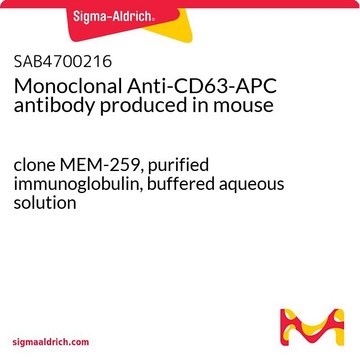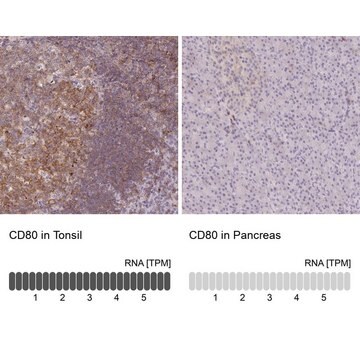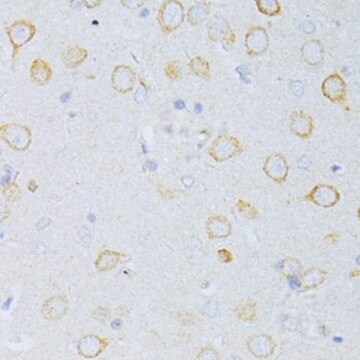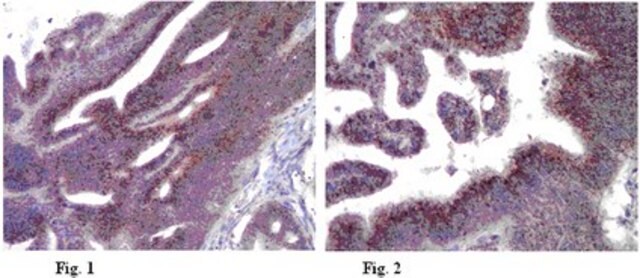MABF2159
Anti-CD63 (LAMP3) Antibody, clone ME491
clone ME491, from mouse
別名:
CD63 antigen, Granulophysin, Lysosomal-associated membrane protein 3, LAMP-3, Melanoma-associated antigen ME491, OMA81H, Ocular melanoma-associated antigen, Tetraspanin-30, Tspan-30
ログイン組織・契約価格を表示する
すべての画像(2)
About This Item
UNSPSCコード:
12352203
eCl@ss:
32160702
NACRES:
NA.43
おすすめの製品
由来生物
mouse
抗体製品の状態
purified immunoglobulin
抗体製品タイプ
primary antibodies
クローン
ME491, monoclonal
化学種の反応性
human
包装
antibody small pack of 25 μg
テクニック
flow cytometry: suitable
immunocytochemistry: suitable
immunohistochemistry: suitable (paraffin)
western blot: suitable
アイソタイプ
IgG1κ
NCBIアクセッション番号
UniProtアクセッション番号
ターゲットの翻訳後修飾
unmodified
遺伝子情報
human ... CD63(967)
詳細
CD63 antigen (UniProt: P08962; also known as Granulophysin, Lysosomal-associated membrane protein 3, LAMP-3, Melanoma-associated antigen ME491, OMA81H, Ocular melanoma-associated antigen, Tetraspanin-30, Tspan-30, CD63) is encoded by the CD63 (also known as MLA1, TSPAN30) gene (Gene ID: 967) in human. CD63 is a multi-pass membrane protein of the tetraspan family that is found on endosome, lysosome, and plasma membranes. CD63 has been detected in platelets, Dysplastic nevi benign moles), radial growth phase primary melanomas, hematopoietic cells, and in tissue macrophages. In melanoma cells it is involved in their motility and adhesion. CD63 also plays a role in the adhesion of leukocytes onto endothelial cells. It is reported to play a role in the activation of ITGB1 and integrin signaling, leading to the activation of AKT, FAK/PTK2 and MAP kinases and promote cell survival, reorganization of the actin cytoskeleton, cell adhesion, spreading and migration. CD63 is a highly N-glycosylated protein with three asparagine glycosylation sites (aa 130, 150, 172) and its ribophorin II (RPN2)-mediated glycosylation has been linked to breast cancer. Overexpression of CD63 has been observed in esophageal cancer that is negatively correlated with tumor stage and lymph node metastasis. Lack of expression of CD63 in platelets has been observed in a patient with Hermansky-Pudlak syndrome (HPS), an autosomal recessive disorder that is characterized by oculocutaneous albinism, bleeding due to platelet storage pool deficiency, and lysosomal storage defects. This antibody (clone ME491) is shown to react with human primary and to some extent with metastatic melanoma tissues. (Ref.: Lai, X., et al. (2017). Oncol. Let. 13(6); 4245-4251; Tominaga, N., et al. (2014). Mol. Cancer 13; 134; Smith, M., et al. (1997). Melanoma Res. 7 (Suppl. 2), 163-170).
特異性
Clone ME491 specifically detects CD63 (LAMP-3) in human cells.
免疫原
Clear supernatant from SK-Mel-23 cell lysate.
アプリケーション
Research Category
炎症及び免疫
炎症及び免疫
Anti-CD63 (LAMP3), clone ME491, Cat. No. MABF2159, is a mouse monoclonal antibody that detects CD63 antigen and has been tested for use in Flow Cytometry, Immunocytochemistry, Immunohistochemistry (Paraffin), and Western Blotting.
Immunohistochemistry (Paraffin) Analysis: A 1:250 dilution from a representative lot detected CD63 (LAMP3) in human spleen and human bone marrow tissue sections.
Immunocytochemistry Analysis: A representative lot detected CD63 (LAMP3) in Immunocytochemistry applications (Atkinson, B., et. al. (1984). Cancer Res. 44(6):2577-81).
Flow Cytometry Analysis: A representative lot detected CD63 (LAMP3) in Flow Cytometry applications (Li, J., et. al. (2003). J Immunol. 171(6):2922-9).
Western Blotting Analysis: A representative lot detected CD63 (LAMP3) in Western Blotting applications (Smith, M., et. al. (1997). Melanoma Res. 7 Suppl 2:S163-70).
Immunohistochemistry Analysis: A representative lot detected CD63 (LAMP3) in Immunohistochemistry applications (Li, J., et. al. (2003). J Immunol. 171(6):2922-9).
Immunocytochemistry Analysis: A representative lot detected CD63 (LAMP3) in Immunocytochemistry applications (Atkinson, B., et. al. (1984). Cancer Res. 44(6):2577-81).
Flow Cytometry Analysis: A representative lot detected CD63 (LAMP3) in Flow Cytometry applications (Li, J., et. al. (2003). J Immunol. 171(6):2922-9).
Western Blotting Analysis: A representative lot detected CD63 (LAMP3) in Western Blotting applications (Smith, M., et. al. (1997). Melanoma Res. 7 Suppl 2:S163-70).
Immunohistochemistry Analysis: A representative lot detected CD63 (LAMP3) in Immunohistochemistry applications (Li, J., et. al. (2003). J Immunol. 171(6):2922-9).
品質
Evaluated by Western Blotting in human platelet lysate.
Western Blotting Analysis: 2 µg/mL of this antibody detected CD63 (LAMP3) in human platelet lysate.
Western Blotting Analysis: 2 µg/mL of this antibody detected CD63 (LAMP3) in human platelet lysate.
ターゲットの説明
~43 kDa observed; 25.64 kDa calculated. Uncharacterized bands may be observed in some lysate(s).
物理的形状
Protein G purified
Format: Purified
Purified mouse monoclonal antibody IgG1 in buffer containing 0.1 M Tris-Glycine (pH 7.4), 150 mM NaCl with 0.05% sodium azide.
保管および安定性
Stable for 1 year at 2-8°C from date of receipt.
その他情報
Concentration: Please refer to lot specific datasheet.
免責事項
Unless otherwise stated in our catalog or other company documentation accompanying the product(s), our products are intended for research use only and are not to be used for any other purpose, which includes but is not limited to, unauthorized commercial uses, in vitro diagnostic uses, ex vivo or in vivo therapeutic uses or any type of consumption or application to humans or animals.
適切な製品が見つかりませんか。
製品選択ツール.をお試しください
試験成績書(COA)
製品のロット番号・バッチ番号を入力して、試験成績書(COA) を検索できます。ロット番号・バッチ番号は、製品ラベルに「Lot」または「Batch」に続いて記載されています。
ライフサイエンス、有機合成、材料科学、クロマトグラフィー、分析など、あらゆる分野の研究に経験のあるメンバーがおります。.
製品に関するお問い合わせはこちら(テクニカルサービス)








